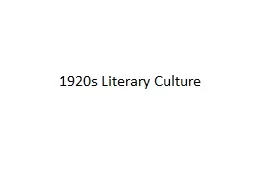

Cultural Liberation Literature and the arts Most of earlier genteel writers had died by 1920s New Yorker Edith Wharton and Virginiaborn Willa Cather continued to be popular Now new modernists becoming popular see Thinking Globally section ID: 577255
Download Presentation The PPT/PDF document "1920s Literary Culture" is the property of its rightful owner. Permission is granted to download and print the materials on this web site for personal, non-commercial use only, and to display it on your personal computer provided you do not modify the materials and that you retain all copyright notices contained in the materials. By downloading content from our website, you accept the terms of this agreement.
Slide1
1920s Literary CultureSlide2
Cultural
Liberation
Literature and the arts:
Most of earlier genteel writers had died by 1920s
New Yorker Edith Wharton and Virginia-born Willa Cather continued to be popular
Now new modernists becoming popular (see Thinking Globally section)
Modernism
questioned social conventions and traditional authorities, considered outmoded by accelerating changes of 20
th
century lifeSlide3
Cultural Liberation
H.L. Mencken best personified this iconoclasm:
Known as
“
Bad Boy of Baltimore
”
Promoted modernist causes in politics and literature
Assailed marriage, patriotism, democracy, prohibition, Rotarians, and other sacred icons of middle-class American
“
booboisie
”
He dismissed South as
“
Sahara of the Bozart
”
Attacked hypocritical do-gooders as
“
Puritans
”
Puritanism, he jibed, was
“
haunting fear that someone, somewhere, might be happy
”Slide4
Cultural Liberation
Young writers jolted by WWI out of complacency about traditional values and literary standards
Probed for new codes of morals and understanding, as well as fresh forms of expression
F. Scott Fitzgerald—
This Side of Paradise
(1920)
“
He found all gods dead, all wars fought, all faiths in man shaken
”
The Great Gatsby
(1925) brilliant commentary on illusory American ideal of self-made man
James Gatz reinvented himself as tycoon Jay Gatsby only to be destroyed by those with wealth and social standingSlide5
p712Slide6
Cultural Liberation
Theodore Dreiser
'
s masterpiece
An American Tragedy
(1925) explored pitfalls of social striving
Ernest Hemingway:
Among writers most affected by WWI
His hard-boiled realism typified postwar writing
The Sun Also Rises
(1926) told of disillusioned, spiritually numb American expatriates in Europe
In
A Farewell to Arms
(1929) he turned his own war story into one of finest novels about the war
His literary successes and flamboyant personal life made him one of most famous writers in world
Won Nobel Prize in literature in 1954Slide7
Cultural Liberation
“
Lost Generation
”
:
Hemingway, Fitzgerald and other American writers and painters formed artistic cadre:
As expatriates in postwar Europe
Found shelter and inspiration in Paris salon of Gertrude Stein:
Studied under William James at Harvard and her early works applied his theory of
“
stream of consciousness
”
Friends with Pablo Picasso and Henri Matisse, she wrote radically experimental poetry and prose
Joined fellow American poets Ezra Pound and T. S. Eliot in vanguard of modernist literary innovationSlide8
Cultural Liberation
“
High modernists
”
:
Experimented with breakdown of traditional literary forms
Exposed losses associated with modernity
Wrote in self-consciously internationalist mode
Haughtily rejected parochialism they found at home
Pound rejected old civilization and proclaimed doctrine:
“
Make It New;
”
he strongly influenced Eliot
Eliot in
The Waste Land
(1922) produced one of most impenetrable but influential poems of century
E.E. Cummings used unorthodox diction and peculiar typesetting to produce startling poetic effectsSlide9
Cultural Liberation
Not all American writers radical:
Many continued familiar regionalist style
Robert Frost wrote hauntingly about nature and folkways of his adopted New England
Carl Sandburg extolled working classes of Chicago in strong, simple cadence
Sherwood Anderson in
Winesburg, Ohio
dissected various fictional personalities, finding them warped by their cramped psychological surroundingsSlide10
Cultural Liberation
Sinclair Lewis:
Main Street
(1920) best-selling story of one woman
'
s unsuccessful revolt against provincialism
In
Babbitt
(1922) he affectionately pilloried George F. Babbitt, who slavishly conforms to respectable materialism of his group
William Faulkner:
Focused on displacement of agrarian Old South by rising industrial order
His work offered fictional chronicle of an imaginary, history-rich Deep South county
In powerful books:
The Sound and the Fury
(1929) and
As I Lay Dying
(1930) he peeled back layers of time and consciousness from constricted souls of his ingrown southern charactersSlide11
Cultural Liberation
Faulkner experimented with multiple narrators, complex structure, and
“
stream of consciousness
”
techniques
His extended meditation culminated in what some consider his greatest work:
Absalom, Absalom!
(1936)
American composers and playwrights made valuable contributions:
Jerome Kern and Oscar Hammerstein
'
s
Show Boat
(1927) was America
'
s first
“
musical play
”
Eugene O
'
Neill
'
s
Strange Interlude
(1928) laid bare Freudian notions of sex and subconscious in succession of dramatic soliloquies
Garnered Nobel Prize in literature (1936)Slide12
Cultural Liberation
Harlem Renaissance:
Black cultural renaissance in uptown Harlem:
Led by writers Claude McKay, Langston Hughes, and Zora Neale Hurston
And jazz artists Louis Armstrong and Eubie Blake
Argued for
“
New Negro
”
who was a full citizen and social equal to whites
Adopted modernist techniques, Hughes and Hurston captured oral and improvisational traditions of contemporary blacks in dialect-filled poetry and proseSlide13
p714Slide14
p715